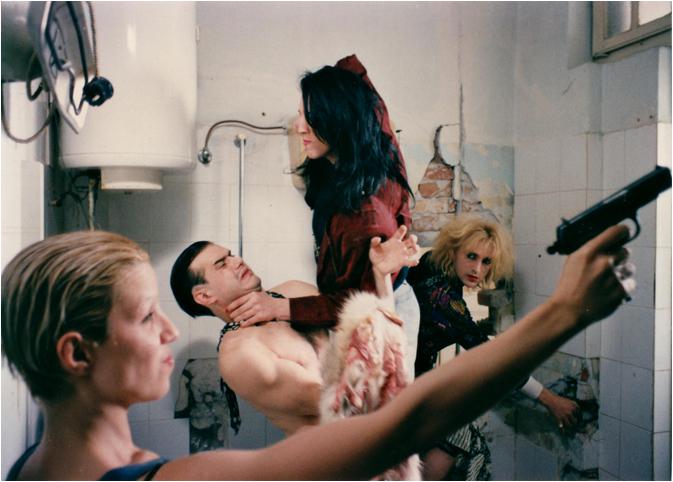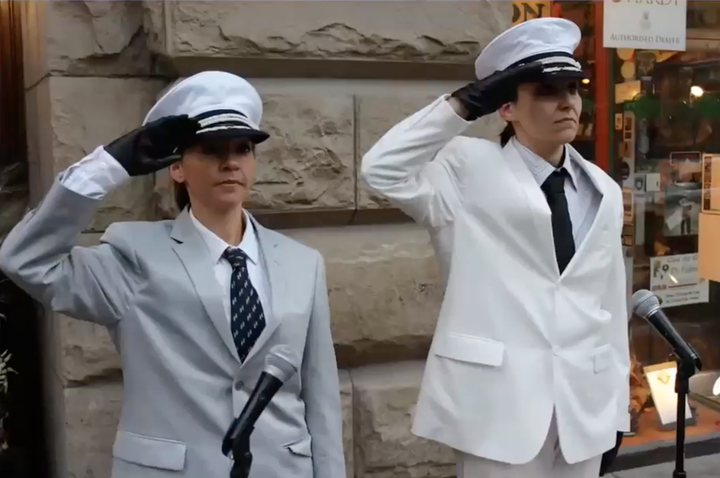In the post-Yugoslav landscape of devastating economic depression caused by the violent emergence of neoliberal capitalism after the collapse of socialist Yugoslavia, one is always already a diasporic subject – because one hails from a country and a system that no longer exist in linear time and space, yet continues to be a powerful generating force of mobilizing action. For the fluid communities that include cultural workers, intellectuals, artists and activists who identify as Yugoslav and hold firmly in the belief that socialist Yugoslavia continues to represent a radical political, economic and cultural project, the diasporic is always already queer – or rather, queering: a process that is anti-categorical, always a verb. It is a movement that defiantly challenges the logic of linear progression typically attached to the capitalist promise of happiness. Framed this way, queer Yugoslav diaspora enacts a return to the utopian promise of revolutionary politics that fervently challenge the inevitability of a dystopian doomsday-scenario which otherwise defines so much of the contemporary leftist political, social and cultural action.
Any standard definition of diaspora often describes it as a population that is scattered across regions separate from its geographic place of origin. But in many ways, diasporas such as Yugoslav are more centrally about temporalities: before and after, and what is in between before and after, what collapses the binary between the two. Yugoslav diaspora is primarily temporal. In fact, in this case, diaspora is timeless, outside of time, always too early and too late at the same time. It is a queering form of temporality in its insistence on upholding a state that officially no longer exists, but becomes a state of mind instead, and is perpetually reproduced affectively, micro-politically, artistically and through activism. For those of us who hold firm in the belief that socialist Yugoslavia was a radical political and social project, being a Yugoslav-identified diasporic subject now is always already an antifascist, anti-capitalist, feminist and yes, queer positionality, a refusal of fixed categories, states of being, positionalities, temporalities and identities in radically subversive ways. To be Yugoslav-identified now is to refuse the logic of capitalist inevitability through the insistence that real existing socialism in Yugoslavia provided a thriving platform for intersecting emancipatory projects crossing, even erasing the borders between gender, sex, class, race, sexuality. In addition, the fact that during its existence, Yugoslavia refused to align itself either with the Soviet Union or the capitalist West, becoming a founding member of the Non-Aligned Movement with a number of African and Asian nations instead, attests to the country’s inherent non-binarism as a founding political principal.
The work of the perennial enfant terrible of Yugoslav and diasporic Yugoslav cultural spaces, filmmaker Želimir Žilnik1 traces in his work many intersecting arcs of Yugoslav radicalism. A pioneer of the Yugoslav Black Wave cinema of the 1960s and early 1970s, Žilnik adheres to the principals of radical amateurism, refusing polished film forms, aesthetics and narratives. Spanning nearly seven decades now, Žilnik’s work refuses to gentrify itself or the numerous subjects it tackles. From documenting the lives of Roma children, working class women or homeless people in Yugoslavia, to the 1970s Yugoslav gastarbeiters in Germany, making sex comedies that defy normative sexual practices, cross-ethnic love stories between Serbs and Kosovars, Žilnik time and again pushes the buttons of respectability politics by revealing messy realities and identities that “leak” rather than cohere. In one of his most radical works (and for Žilnik, this is saying a lot), feature narrative Marble Ass (1995), Žilnik creates a film that is a shock to the system already shaken and paralyzed by the annihilating violence of the 1990s Yugoslav wars. In the midst of the ethno-nationalist fervor, violence and war-mongering, by now a cult classic Marble Ass centers on two trans protagonists, played by non-professional trans actors Vjeran Miladinović Merlinka (in the film she goes by Merlin, after Marilyn Monroe)2, and Milja Milenković (who plays Sanela). Merlin and Sanela, who are sex workers, create for themselves a queer kind of diaspora, existing in what J. Jack Halberstam has elsewhere described as a queer time and place.3 Against the temporal and spatial logic of the enveloping violence, the two trans women are seen as the only sane characters who refuse to embrace hate and destruction. As I have written elsewhere,4 the film stages a brilliant reversal – it is the cis-hetero-ethno-nationalist masculine ‘ideal’ that is exposed as sick (“sicko” being Merlin and Sanela’s preferred term), while the trans sex workers are the only individuals capable of affirmative and thriving forms of affect. Merlin even speaks of her sex work as a form of humanitarianism: providing love and bodily pleasure in the face of all-encompassing hate. The spatial and temporal queer enclave of Marble Ass is shown to be the alternative to the cis-hetero-nationalist violence that is actively destroying the legacies of socialist Yugoslavia. Merlin and Sanela become stand-ins for Yugoslavia’s non-alignment, as they hold onto the non-binary, intersectional emancipatory legacies of the country that is being demolished by toxic masculinity all around them (embodied by the character of war veteran Džoni). Even though the film is nearly thirty years old as of this writing, it remains one of the most radical queer interventions in the Yugoslav diasporic cultural, political and social landscape, prompting queer writer and film critic Mima Simić to recently quip that “Žilnik is the queerest one of us all.”5
Queering Tito
In a queer turn of events, socialist Yugoslavia’s lifetime president, Josip Broz Tito, has become a frequent subject in the work of many diasporic Yugoslav non-conforming artists. This is not surprising, as Tito is a symbolic embodiment of Yugoslavia’s legacy. In the reactionary, revisionist narratives of Yugoslavia, Tito is frequently and inaccurately dismissed as a “dictator”. In the works of many contemporary Yugoslav diasporic artists, Tito instead becomes a queer subject of love, respect and affection, an appropriation that flies in the face of ethno-nationalist revisionism which dismisses socialist legacies as dictatorial and seeks to embrace neoliberal capitalist corruption instead.
Here again, as it is customary for his pioneering work and perennially defiant creative instincts, Želimir Žilnik is first out of the gate. In 1994, while Serbia is actively engaged in the armed conflicts in Bosnia and Croatia, Žilnik directs a docudrama Tito’s Second Time Among the Serbs (Tito himself died in 1980, a key turning point that precipitated the rise of ethno-nationalism, which Tito himself was vehemently against, favoring pan-Yugoslavism instead). In his docudrama, Žilnik enlists a popular Serbian comedian Dragoljub Ljubičić to dress up as Tito (in full military uniform and regalia) and walk the streets of Belgrade fully in character, conversing with the residents he encounters on the street, as Žilnik’s camera documents the interactions. While all residents that this “Tito” in drag encounters would be fully aware that Tito himself had been dead for more than a decade, and moreover, most of them would recognize the popular comedian that is playing him here, every single person immediately starts conversing with “Tito” as Tito, not questioning the roleplay but, rather, spontaneously playing along with it. The residents of Belgrade engage in humorous banter with Tito, take the opportunity to inform him of what had transpired since his death. Some claim it is all his fault because he left, others take the opportunity to tell him he is missed. In the staging of these queer encounters (as they queer time, place and identity alike), the Tito in drag is an object of affection, engagement, a much needed invitation to speak one’s mind, vent and commiserate.
In the performance piece titled Summit, Yugoslav diasporic performance artist and academic Bojana Videkanić embodied a female Tito on the streets of Calgary, Canada in 2012, alongside a fellow performance artist from Egypt, Nahed Mansour, who embodied the Egyptian president Nasser, in what the two whimsically referred to as “dictator-drag”. As the two women stood in uniforms, (Videkanić wore a replica of Tito’s iconic white uniform and hat), they saluted unsuspecting Canadians, who did not know how to engage with or interpret what the silently saluting women in ceremonial attire and hats were actually doing. They were unreadable to most, except, as Videkanić herself described,6 to the taxi drivers, most of whom, in this particular region of Canada, are African immigrants. While white Canadians did not attempt to engage, the immigrant taxi drivers honked and enthusiastically saluted the female Tito and Nasser back, testifying to the histories of solidarity and recognition between the non-aligned, non-Western subjects. The performance was designed to recall the legacies of the Non-Aligned Movement, and ended in the two leaders holding a snowball between their mouths as it slowly melted, gradually drawing their lips into a frozen kiss.
Other Yugoslav performance artists engage with their versions of Tito too, including the queer activist and artist Zoe Gudović, who resides and creates in Belgrade. In their version of the performance, Tito is in double drag, as embodied by a non-binary drag performer. Likewise, intersectionality looms large in multimedia artist Selma Selman’s7 take on Tito. As a queer, Yugoslav-identified Roma artist who comes from a working class and rural background, Selman draws on all these elements in her “Selma Selman Is Tito” engagement. Using the international prominence she gained as an artist, Selman frequently gives back to her impoverished Bosnian village of origin, an initiative that earned her a nickname of Tito among the villagers, as both gave back to the ordinary people. This prompted Selman to paint on her van the slogan “Selma Selman is TITO,” embracing the comparison, and the legacy of the socialist leader. As the artist herself has stated, “[e]verybody here looks at me as Tito, because I bring them happiness.”8 A queer female Roma artist thus embodies Tito in intersectional ways that return to the present the legacy and performance of Yugoslavia’s own radically intersectional socialist project.
A black and queer Yugoslav diasporic artist Christian Guerematchi engages with a similar intersectionality in his video performance Black Tito Addressing the Parliament of Ghosts, Ghana (2023). As a child of a Yugoslav mother and a father from Central African Republic who came to Yugoslavia as a student during the Non-Aligned Movement, Guerematchi represents an embodied legacy of the non-alignment and actively engages with it in his artwork. In Black Tito, Guerematchi adds additional blackness to Tito by covering his own face with black cloth, while dressed in Tito’s iconic white suit and hat, and addressing the titular parliament of ghosts (his listeners are invisible), recalling Tito’s speech and the tenets of non-alignment, as well as the legacies of Yugoslav socialism as a more just and egalitarian system for the people. By embracing and embodying the black Tito, Guerematchi is also calling attention to the Balkan’s own positionality as not-quite-white from the dominant perspective of Western Europe, a perspective from which Balkan identity is a racialized identity.
In the works of these and many other queer Yugoslav diasporic artists, Yugoslavia is queer and constituted anew, its legacies urgent and vibrant against the landscape of the ever advancing neoliberal capitalist devastation, precarity and dispossession. To be Yugoslav today is to be queerly diasporic, embracing non-fixated subjectivities rather than categorical identities. It is a practice of micropolitics on the level of artistic creativity and everyday life, where the potentiality and reality of a more egalitarian, socialist society is assembled anew.
1 Žilnik was given a career retrospective titled Shadow Citizens in 2021, curated by WHW at Kunsthalle Wien https://kunsthallewien.at/en/exhibition/zelimir-zilnik-shadow-citizens
2 Miladinović also appears in Žilnik’s earlier film, Pretty Women Walking Through the City (1986).
3 J. Jack Halberstam, In a Queer Time and Place: Transgender Bodies, Subcultural Lives. New York 2005.
4 Dijana Jelača, Dislocated Screen Memory: Narrating Trauma in Post-Yugoslav Cinema. New York 2016.
5 Round table, Symposium “Queer and Feminist Yugoslav Diaspora, Art, Film, Activism,” University at Buffalo, April 23–27, 2023.
6 Personal correspondence.
7 In 2022, Selma Selman had an exhibition at Kunstraum Innsbruck, curated by Ivana Marjanović https://www.kunstraum-innsbruck.at/en/archives/exhibitions/selma_selman
8 As quoted in Jasmina Tumbas, I Am Jugoslovenka: Feminist Performance Politics During and After Yugoslav Socialism, Manchester 2022, p. 278.




